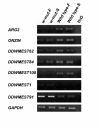Differential gene expression profile in the small intestines of mice lacking pacemaker interstitial cells of Cajal
- PMID: 12831403
- PMCID: PMC198276
- DOI: 10.1186/1471-230X-3-17
Differential gene expression profile in the small intestines of mice lacking pacemaker interstitial cells of Cajal
Abstract
Background: We previously identified eight known and novel genes differentially expressed in the small intestines of wild type and W/WV mice, which have greatly reduced populations of the interstitial cells of Cajal, that are responsible for the generation of electrical slow waves, by using a differential gene display method.
Methods: By using the same method we isolated additional candidate genes that were specifically down- or up-regulated in W/WV mice. Novel transcripts were designated as DDWMEST.
Results: We isolated seven candidates that were specifically down- or up-regulated in W/WV mice. Two novel transcripts, DDWMEST 1 and -91 were increased in both fed and fasted W/WV mice. Expression of another five genes was suppressed in W/WV mice: ARG2 (Arginase II), ONZIN (encoding leukemia inhibitory factor regulated protein), and three novel transcripts: DDWMEST62, -84, and -100. Together with the previous report, we identified fifteen differentially expressed genes in total in the small intestines of W/WV mice. Eight of these genes were reduced in the jejunums of W/WV mice compared to age matched wild type mice, whereas the other seven genes showed an increase in expression. Differential expression was the same in fasted and fed animals, suggesting that the differences were independent of the dietetic state of the animal.
Conclusions: Several known and novel genes are differentially expressed in the small intestines of W/WV mice. Differential gene comparison might contribute to our understanding of motility disorders associated with the loss of the interstitial cells of Cajal.
Figures

Similar articles
-
Novel human and mouse genes encoding a shank-interacting protein and its upregulation in gastric fundus of W/WV mouse.J Gastroenterol Hepatol. 2003 Jun;18(6):712-8. doi: 10.1046/j.1440-1746.2003.03046.x. J Gastroenterol Hepatol. 2003. PMID: 12753155
-
Novel human, mouse and xenopus genes encoding a member of the RAS superfamily of low-molecular-weight GTP-binding proteins and its downregulation in W/WV mouse jejunum.J Gastroenterol Hepatol. 2004 Feb;19(2):211-7. doi: 10.1111/j.1440-1746.2004.03298.x. J Gastroenterol Hepatol. 2004. PMID: 14731133
-
Differential gene expression in the murine gastric fundus lacking interstitial cells of Cajal.BMC Gastroenterol. 2003 Jun 10;3:14. doi: 10.1186/1471-230X-3-14. BMC Gastroenterol. 2003. PMID: 12795813 Free PMC article.
-
[Interstitial cells of Cajal and gastrointestinal diseases].Zhongguo Dang Dai Er Ke Za Zhi. 2006 Apr;8(2):164-8. Zhongguo Dang Dai Er Ke Za Zhi. 2006. PMID: 16613718 Review. Chinese. No abstract available.
-
Interstitial cells of Cajal: is their role in gastrointestinal function in view of therapeutic perspectives underestimated or exaggerated?Folia Morphol (Warsz). 2001;60(1):1-9. Folia Morphol (Warsz). 2001. PMID: 11234692 Review.
Cited by
-
Effects of ginsenoside Re on rat jejunal contractility.J Nat Med. 2014 Jul;68(3):530-8. doi: 10.1007/s11418-014-0831-2. J Nat Med. 2014. PMID: 24658813
-
Ginsenoside Re inhibits pacemaker potentials via adenosine triphosphate-sensitive potassium channels and the cyclic guanosine monophosphate/nitric oxide-dependent pathway in cultured interstitial cells of Cajal from mouse small intestine.J Ginseng Res. 2015 Oct;39(4):314-21. doi: 10.1016/j.jgr.2015.02.004. Epub 2015 Mar 6. J Ginseng Res. 2015. PMID: 26869823 Free PMC article.
References
Publication types
MeSH terms
Substances
Grants and funding
LinkOut - more resources
Full Text Sources
Research Materials

